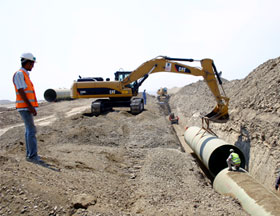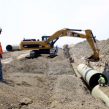
Azerbaijan Opens New Water Pipeline
Publication: Eurasia Daily Monitor Volume: 8 Issue: 5
By:

After almost four years of construction, the Oguz-Gabala-Baku water pipeline was inaugurated on December 28, 2010. Costing almost $1 billion, the pipeline is already termed by many in Azerbaijan as the “second BTC,” referring to the strategically important Baku-Tbilisi-Ceyhan pipeline built a decade ago to transport Caspian oil to global markets. This time, the water pipeline will carry fresh water from the Caucasus Mountains to Baku, which has been traditionally short of drinking water. “This is truly a historic event. This is a huge achievement. It shows that Azerbaijan as an independent state is capable of everything,” President Ilham Aliyev said during the inauguration ceremony (www.presiden.az, January 1, 2011).
The project was first initiated back in 1970’s, but due to lack of funds construction never materialized. Meanwhile, Baku remained in deep need of fresh water. Located on the semi-desert Absheron peninsula, Baku’s growth was historically driven by the booming oil industry. This required the importing of drinking water from outside of the city. The first such pipeline, delivering water from Shollar springs, was built in the pre-Soviet period by the then-philanthropist Haci Zeynalabidin Tagiyev. The second pipeline, delivering purified water from the Kura River, was built during the Soviet era. Yet, both pipelines did not meet the demand of the population in the city. A majority of households (60 percent) still receive water for only a few hours daily (Trend News Agency, December 29).
Azerbaijan’s increasing oil revenues enabled the Oguz-Gabala-Baku water pipeline project to be placed on the agenda. In 2005, President Aliyev initiated the construction of the pipeline. As a result of this project, 75 percent of the capital city’s population of 3,000,000 (mainly citizens of Yasamal, Nasimi, Narimanov, Sabayil and Binagadi districts) is expected to receive drinking water around the clock. This drinking water will be up to the standards set by the World Health Organization. The pipeline is 2 meters wide in diameter and 262 kilometers long. What is unique about this pipeline is that it does not use any pumping stations. The water naturally flows to the capital city, due to the altitude differences. Each second, 5 cubic meters of water will enter the pipeline, delivering a total of 430 cubic meters of water daily. The extra quantity of water will be deposited in Ceyranbatan water reservoir. Together with the pipeline, seven water reservoirs, chlorine stations, water management stations, laboratories, processing stations, water distribution systems, and critical infrastructure SCADA security systems were also built and installed as part of the project (Trend News Agency, December 29).
President Aliyev announced additional measures to further improve the water situation in the capital city, including the construction of the Takhtakorpu water reservoir and the Absheron-Samur water canal. The water distribution pipe network in the city itself has also been modernized in recent years. What makes this project of special pride for Azerbaijanis is that it required no foreign investment. The entire project was financed by the State Oil Fund. This symbolic act by the government also signals that oil revenues are spent on socially-important projects. Indeed, the Oguz-Gabala-Baku water pipeline is not a commercial project, but a humanitarian one, aimed at improving the health standards of the people. President Aliyev also highlighted the water purification stations, built along the Kura River, which already benefits 300,000 people.
Ali Masimli, a Member of the Parliamentary Economic Committee, said that the pipeline is “the most important project not only in 2010, but of the last 20 years” (Trend News Agency, December 29). Launching the water pipeline complemented the “Year of Ecology,” proclaimed by the government in 2010. More than 6,000,000 trees were planted, new Euro-2 standards for cars were applied, construction of new waste management plant began, and the Balaxani waste ground in the suburbs of Baku was cleaned in 2010.
The economic boom in Azerbaijan continues to be the main success story for the ruling party In his New Year’s message televised to the nation, President Aliyev once again emphasized the economic development of the country. “Despite the global financial crisis, our GDP grew by 5 percent, household income level by 12 percent, currency reserves from $20 billion to $29 billion. Some $15 billion of investment was attracted into the economy. In 2010 alone, 45 hospitals, 70 secondary schools and 5 Olympic centers were built. This shows that the path chosen by Azerbaijan is the right one” (www.presiden.az, January 1, 2011).




